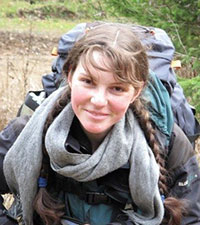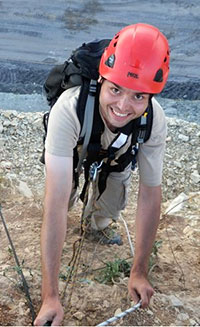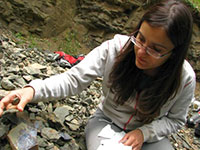 Emilia Jarochowska
Emilia Jarochowska
GeoZentrum Nordbayern
Fachgruppe Paläoumwelt
Universität Erlangen-Nürnberg
Loewenichstrasse 28
|91054 Erlangen
Germany
Emilia.Jarochowska@gzn.uni-erlangen.de
Emilia Jarochowska has graduated in biology (2010) and geology (2012) at the University of Warsaw, Poland. She is now doing a PhD project at the University of Erlangen-Nuremberg, Germany, under the supervision of Axel Munnecke. She works on a model for the sea-level development and the biotic turnover during the middle Silurian Mulde Event, employing conodonts, graptolites and stable carbon isotopes in sections located in Poland and Ukraine.

 Petra Tonarová
Petra Tonarová
Institute of Geology at Tallinn University of Technology
Ehitajate tee 5
19086 Tallinn
Estonia
and Czech Geological Survey
Geologická 6
152 00 Prague 5
Czech Republic
petra.tonarova@geology.cz
Petra Tonarová is a postdoctoral researcher in the Institute of Geology at Tallinn University of Technology. Since 2007 she has been a part-time researcher at the Czech Geological Survey in Prague. In 2012, she received a PhD degree from the Charles University in Prague, Czech Republic, based on the study on the Silurian scolecodonts of the Prague Basin. Her research is focusing on the lower Palaeozoic micropalaeontology, mainly scolecodonts (jaws of polychaete worms).

 Axel Munnecke
Axel Munnecke
GeoZentrum Nordbayern
Fachgruppe Paläoumwelt
Universität Erlangen-Nürnberg
Loewenichstrasse 28
91054 Erlangen
Germany
Axel.Munnecke@gzn.uni-erlangen.de
Axel Munnecke is a carbonate sedimentologist and palaeontologist at the University Erlangen-Nuremberg, Germany. He graduated in 1993 and completed his PhD at the university in Kiel (Germany) in 1996. From 1996 to 2002 he worked at the universities of Bremen (Germany), Lille (France), and Tübingen (Germany). Since then he works as assistant professor in Erlangen. His research interests are (a) palaeoclimate reconstructions based on facies analysis and stable C- and O-isotopes, (b) reconstruction of palaeoenvironmental changes during times of strong isotopic shifts in the Ordovician and Silurian, (c) correlation of bio- and chemostratigraphy, (d) origin and diagenesis of calcareous rhythmites (especially limestone-marl alternations), and (e) calcareous Palaeozoic micro- and nannofossils as fossil counterparts to modern calcareous plankton. Since 2003 he is organising the renowned annual “International Course on Carbonate Microfacies (Flügel Course)” in Erlangen, Germany.

 Lenka Ferrová
Lenka Ferrová
Czech Geological Survey
Geologická 6
152 00 Prague 5
Czech Republic
and Faculty of Science
Charles University in Prague
Albertov 6
128 43 Prague 2
ferrova@natur.cuni.cz
Lenka Ferrová is a PhD student at the Charles University in Prague and the research worker of the Czech Geological Survey. Her Bsc. and Master thesis dealt with Devonian Daleje Bioevent (Emsian, Lower Devonian). She studied the dacryoconarid tentaculites biostratigraphy, carbonate sedimentology and paleoecology with application of paleontological numerical methods on sections in the Barrandian area (Czech Republic). Her work brought new important data for long-running discussion on the subdivision of the Emsian Stage. She has worked on several sections from the same stratigraphical level in Nevada and New South Wales. Obtained material from Australia and North America together with ongoing research in the Barrandian area form the basis of her Ph.D.

 Jan Sklenář
Jan Sklenář
Palaeontological Department
Natural History Museum
National Museum
Václavské náměstí 68
115 79 Praha 1
Czech Republic
jan_sklenar@nm.cz
Jan Sklenář has worked as a curator of the Mesozoic Invertebrates collection at the National Museum in Prague since 2004. His primary interests are Late Cretaceous brachiopods, but he also studies other members of marine benthic communities, like polychaete worms. The Late Cretaceous brachiopods and polychaetes of the Bohemian Cretaceous Basin are also the topic of his Ph.D. thesis, completed in 2013. As a collection manager, he also deals with preventive and remedial conservation of fossils with iron-sulphide content. He is the leader of a group of palaeontologists, mineralogists and research chemists currently addressing this issue. Furthermore, he is interested in graphic and illustration techniques that have been employed in palaeontology throughout the history of the discipline.

 Stanislava Vodráková
Stanislava Vodráková
GeoZentrum Nordbayern
Fachgruppe Paläoumwelt
Universität Erlangen-Nürnberg
Loewenichstrasse 28
91054 Erlangen
Germany
and Czech Geological Survey
P.O.B. 85
118 21 Prague 1
Czech Republic
stana.vodrazkova@seznam.cz
Stanislava Vodrážková finished her PhD in 2010 on environmental changes close to the Lower-Middle Devonian boundary in the Prague Basin (Basal Choteč Event), Czech Republic. She is currently a postdoctoral researcher at GeoZentrum Nordbayern, Friedrich-Alexander University of Erlangen-Nürnberg, studying the Middle Devonian Kačák Event. Her main research topics are conodont and tentaculite biostratigraphy, carbonate sedimentology and stable isotope geochemistry.


